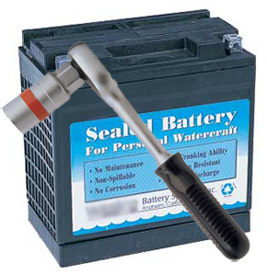| Use | Prep | Post-Ride | Storing |
What is a PWC?
Laws & Rules
Places to Ride
Photo Gallery
To properly winterize your personal watercraft, you need to start with washing the inside of the hull with degreaser and the outside with auto wash soap. Vacuum all remaining water from storage compartments and hull. Remove the drive shaft cover to access the grease fittings for the drive train. Grease the drive train with water resistant grease, and then reinstall cover. Replace the spark plugs with new. Add fuel stabilizer to the fuel according to the directions on product. Remove fuel filter, clean or replace. Remove the cooling hose on the head and blow compressed air through the line and the head. A wet/dry shop vac can also remove the water. Reinstall the line. Start and run engine for 15-20 seconds, this will circulate the fuel stabilizer through the fuel lines and carburetors. Let the engine cool for 30 minutes.
On Sea-Doo models, you will need to change the pump oil with new. Do NOT use just any gear oil. Use gear oil such as Slick 50 Gear Oil or Sea-Doo pump oil. On some models of personal watercraft, there will be a removable plug on the flame arrestor to spray fogging oil through. Start the motor and spray fogging oil down in the carburetors through the access hole. Spraying for 10 seconds will be plenty of oil. Over kill will just make it hard to start in the spring.
Remove the battery and top it off with distilled water. Install your Battery Tender, Jr. to maintain your battery in off season. Install your cable lube adapter to the throttle cable and oil injection cable. Spray Cable Life to pressure lube the cables. Do not use WD40, its a solvent. Dress the motor with fogging oil and wipe it down. Now, you are finished with your winterizing.
 Battery Storage & Battery Charging
Battery Storage & Battery Charging
These are some general battery storage and charging guidelines to winterize your PWC battery. Always check your specific battery chargers instructions for further safety information.
Remove the battery from the PWC. Clean the terminals and battery case with a mixture of baking soda and water. Next, check the water level of each cell and add distilled water as necessary. Maintenance Free or Gel type batteries can skip this step.
Store your battery in a cool, dry, well-ventilated area. Make sure this location is out of the reach of children and curious pets. Do not store your battery where the temperature will drop below freezing (32F degrees). Although a fully charged lead acid battery can withstand extreme temperatures exceeding minus 40F degrees, a discharged battery can freeze at 32F degrees.
Attach your Battery Tender, Jr. trickle charger. Be sure to following manufactures instructions and safety tips. Finally, check the battery water level every month or so.
Note about storing batteries on concrete - According to the battery experts storing your battery on a concrete surface will NOT cause the battery to discharge prematurely. Apparently older hard rubber style battery cases did indeed conduct a current when placed on a concrete surface with a high moisture content. This commonly held (and often repeated) myth does not apply to modern plastic battery materials.